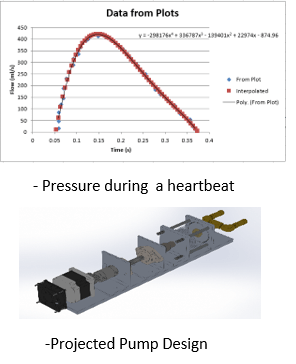Programmable Controls for a Cardiac Pulsatile Flow Pump
Student: Ryan Plemmons
Major Professor: Dr. Morten Jensen
Research Area(s):
Microelectronics
Biological Materials & Processes
Background/Relevance
- Pulsatile pumps can be used to recreated pulse patterns of the heart to allow research into cardiovascular flow patterns
- Pulsatile pumps on the market are very expensive and can cost at least $250,000.
Innovation
- Utilize a stepper motor and Pulse Width Modulation to create a low cost pulsatile pump.
- Allow for more accurate control of the pump to input different pulses and simulate a variety of situations.
Approach
- Create a polynomial equation from data of heartbeat pressures.
- Evaluate the polynomial over a time step and a number of interpolations.
- Calculate the values of the polynomial at each timestep.
- Produce a duty cycle for Pulse Width Modulation for each value calculated.
- Input the series of Pulse Width Modulations to a pump to simulate heart beats.

Key Results
- An array is built in order to calculate the appropriate time steps based on input from the user.
- The program also calculates the values at each timestep based on the polynomial that was calculated.
- The array of polynomial values is then transformed into duty cycle values to input into Pulse Width Modulation.
- The program can potentially run the Pulse Width Modulation within itself, or it can send the data out to a different program for more control or variability.

Conclusions
- The LabVIEW program can successfully take a flow pressure plot generated by a heart beat and return an array of values to be transformed into information for pulse width modulation.
- The cost of manufacturing the in-lab pump is much less expensive and easily within budget for the lab.
